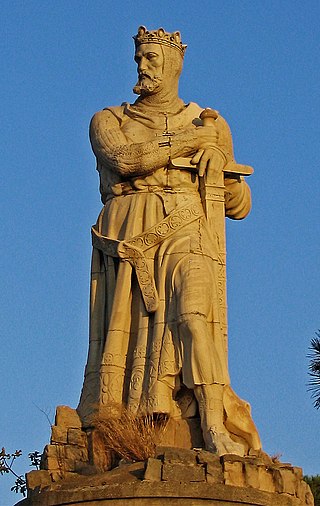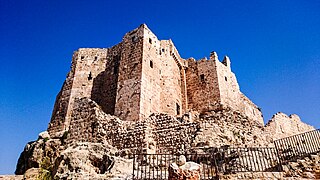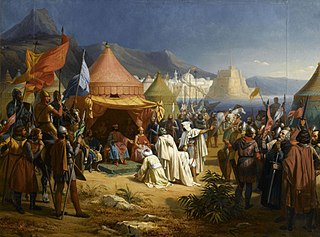
Damascus is the capital of Syria, the oldest capital in the world and, according to some, the fourth holiest city in Islam. Known colloquially in Syria as aš-Šām (الشَّام) and dubbed, poetically, the "City of Jasmine", Damascus is a major cultural center of the Levant and the Arab world.

Year 1104 (MCIV) was a leap year starting on Friday of the Julian calendar.

The Order of Assassins or simply the Assassins were a Nizari Isma'ili order that existed between 1090 and 1275 AD, founded by Hasan-i Sabbah.

The Zengid or Zangid dynasty was an Atabegate of the Seljuk Empire created in 1127. It formed a Turkoman dynasty of Sunni Muslim faith, which ruled parts of the Levant and Upper Mesopotamia, and eventually seized control of Egypt in 1169. In 1174 the Zengid state extended from Tripoli to Hamadan and from Yemen to Sivas. Imad ad-Din Zengi was the first ruler of the dynasty.
Imad al-Din Zengi, also romanized as Zangi, Zengui, Zenki, and Zanki, was a Turkoman atabeg, who ruled Mosul, Aleppo, Hama, and, later, Edessa. He was the namesake of the Zengid dynasty.

Nūr al-Dīn Maḥmūd Zengī, commonly known as Nur ad-Din, was a member of the Zengid dynasty, which ruled the Syrian province of the Seljuk Empire. He reigned from 1146 to 1174. He is regarded as an important figure of the Second Crusade.
Abu Nasr Shams al-Muluk Duqaq was the Seljuq ruler of Damascus from 1095 to 1104.
Ridwan was a Seljuk emir of Aleppo from 1095 until his death.
Najm ad-Din Ilghazi ibn Artuq was the Turkoman Artukid ruler of Mardin from 1107 to 1122. He was born into the Oghuz tribe of Döğer.
Mu'in ad-Din Unur al-Atabeki was a mid-12th century ruler of Damascus from 1140 to 1149. He was a Turkoman slave of Burid emirs.
The Battle of Marj al-Saffar was fought on January 25, 1126 between a Crusader army led by King Baldwin II of Jerusalem and the Seljuk Emirate of Damascus, which was ruled by Toghtekin. The Crusaders defeated the Muslim army in the field but failed in their objective to capture Damascus.
Zahir al-Din Toghtekin or Tughtekin, also spelled Tughtegin, was a Turkoman military leader, who was emir of Damascus from 1104 to 1128. He was the founder of the Burid dynasty of Damascus.
Taj al-Muluk Buri was an atabeg of Damascus from 1128 to 1132. He was initially an officer in the army of Duqaq, the Seljuk ruler of Damascus, together with his father Toghtekin. When the latter took power after Duqaq's death, Buri acted as regent and later became atabeg himself. Damascus's Burid dynasty was named for him.
By the late 11th century, the Shi'a sub-sect of Ismailism had found many adherents in Persia, although the region was occupied by the Sunni Seljuk Empire. The hostile tendencies of the Abbasid–Seljuk order triggered a revolt by Ismailis in Persia under Hassan-i Sabbah. Siege of Maysaf
The Banu Munqidh, also referred to as the Munqidhites, were an Arab family that ruled an emirate in the Orontes Valley in northern Syria from the mid-11th century until the family's demise in an earthquake in 1157. The emirate was initially based in Kafartab before the Banu Munqidh took over the fortress of Shayzar in 1081 and made it their headquarters for the remainder of their rule. The capture of Shayzar was the culmination of a long, drawn-out process beginning with the Banu Munqidh's nominal assignment to the land by the Mirdasid emir of Aleppo in 1025, and accelerating with the weakened grip of Byzantine rule in northern Syria in the 1070s.
Shams al-Mulk Isma'il was the Burid atabeg of the Emirate of Damascus from 1132 to 1135.
Irtash was a Seljuk emir of Damascus in 1104. Irtash was born to Taj ad-Dawla Tutush, the brother of the Seljuk Sultan Malik-Shah I who established a principality in Syria after his brother gave the region and the adjacent areas to him. Following the death of Malik-Shah, Tutush claimed the Seljuk crown, but he was killed by the forces of his nephew Berkyaruq near Ray. Subsequently, Irtash's brother Ridwan moved to Aleppo and proclaimed himself the new emir. Irtash's other brother Duqaq's declaration of a new emirate in Damascus separated the Syrian Seljuk state into two and started a rivalry between the two brothers. Duqaq then imprisoned Irtash for nine years in Baalbek.
Abū ʿAbdallāh Muḥammad ibn Naṣr (1085–1154), known as al-Qaysarānī or Ibn al-Qaysarānī, was a Syrian Muslim poet who wrote in Arabic under the Zangid dynasty. He had a broad and scientific education, which included a sojourn in Iraq. He was one of the most renowned poets of his age, and the most prolific Zangid propagandist. He wrote extensively against the Crusades for his masters.

Fakhr al-Mulk ibn Ammar was the last qadi of Tripoli, from 1099 to 1109, before the city was taken by the Crusaders.
Tutush Ibn Duqaq Ibn Tutush Seljuki, commonly known as Tutush II, was an infant Emir of Damascus.






